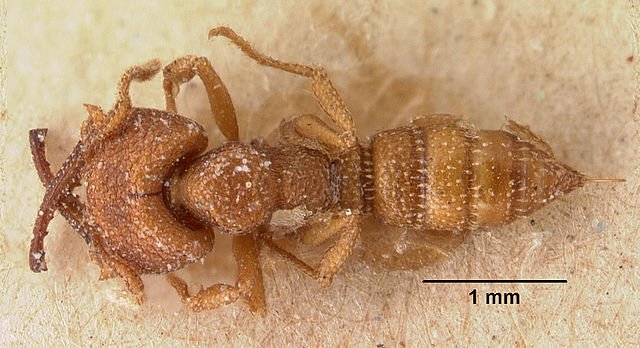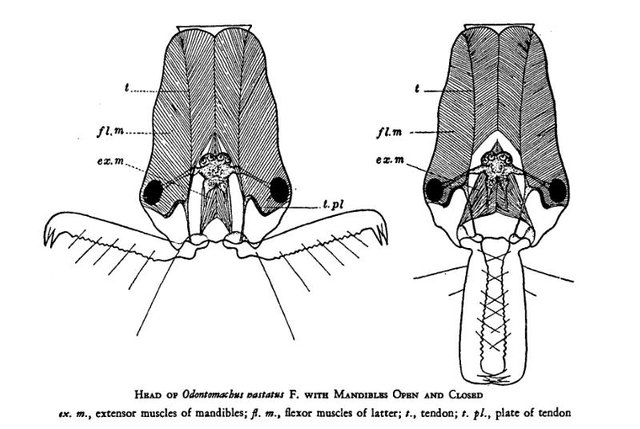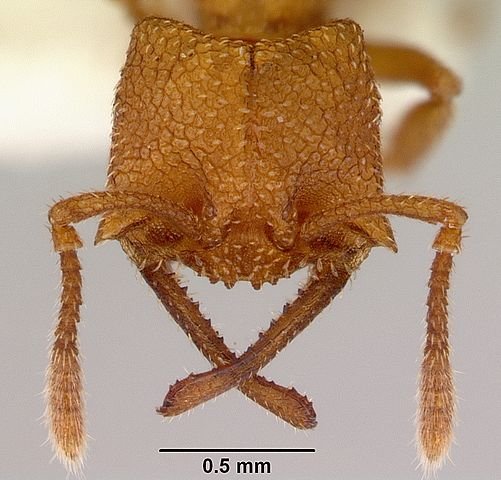This Dracula Ant Has The Fastest Moving Appendage We've Ever Measured
Whoa, Whoa, Whoa! Dracula Ant?
The Dracula ant is the common name given to ants belonging to the subfamily of Formicidae (ants) called Amblyoponinae. This subfamily is comprised of 9 known living genera and 1 known extinct genus. It is a very diverse group of ants with 140 known living species spread throughout tropical and temperate regions worldwide. They derive their spooky moniker from the fact that feed off of the hemolymph (invertebrate form of blood) of their larvae. Now, this doesn't usually kill the poor little babies. Instead, I imagine that it's just mommy's way of saying 'I will EAT you if you get out of line!'Mystrium camillae

Image Credit: April Nobile / © AntWeb.org / CC BY-SA 3.0
Mystrium camillae
But, enough about drinking the blood of babies. Let's talk about the fastest biter of all the vampires, Mystrium camillae. This particular species of ant can be found in northern Australia and the nearby islands, as well as in parts of India and China. So, what is so cool about this little insect? Its snap-like jaws are able to reach speeds of 200 mph while closing in as little as 0.000015 seconds (90 m/s). That gives it the fastest known motion of any animal appendage on Earth, easily dethroning the trap jaw ant, which can accelerate its jaw to speeds of 143 mph in .0001 seconds (64 m/s).Trap Jaw Vs. Snap Jaw
When I first started reading about this new bite-speed record, I imagined little ant mandibles piercing into my finger at blindingly fast speeds. However, when I watched the high speed video, it wasn't anything like I had expected. But, I discovered that the difference lies in the name snap jaw.Trap Jaws
When most of us think of a biting ant, we imagine pincer-like jaws that close to squeeze and pierce their target. Trap jaw ants take this concept to the extreme! They are able to spring load their jaws by hyper-extending them back 180 degrees toward the head and locking them into place like in the illustration below.
Image Credit: W M Wheeler [Public domain], via Wikimedia Commons
The mechanism used to spring load the jaws differs among different species of trap jaw ants, but the release mechanism usually involves trigger hairs located on the mandibles that are connected to the neurons that cause the lock to release. When one of those trigger hairs are touched, the jaws SLAM shut.
The trap jaw ant uses its spring loaded bite for many different purposes. Of course, they can be used to dismantle potential prey or to ward off predators, but studies show that they can also be used for locomotion. Those little jaws move so fast that the bite force at the end of the appendages exceeds the weight of the ant. As a result, if the ant 'bites down' onto a solid substrate (a large rock or the ground, for example), the force will be reflected back onto the ant, propelling through the air to distances many times their body length. They are even able to vary the force that they exert, allowing them to have different escape strategies for different situations. They've even been known to use their jaws to eject predators that got too close for comfort.
Snap Jaws
Snap jaws, on the other hand, are entirely different. Their name comes from the fact that they work in much the same way as we snap our fingers. When we snap, we start by leveraging our middle finger against our thumb. That leverage increases until our thumb slips out of the way, allowing the middle finger to strike the palm of the hand. This impact is where the snap sound comes from. Check out this super cool high speed footage if you want to see.
Image Credit: April Nobile / © AntWeb.org / CC BY-SA 3.0
When a snap jaw ant's mandibles are at rest, they overlap each other, as seen in the above picture. To 'charge' their jaw, they press the tips of the mandibles together and leverage one against the other by repeatedly flexing the mandibles to build up tension. One mandible is built to hold more tension than the other, so, when the ant is ready to strike, it slides this faster moving jaw over the top of the slower moving one (kind of like how you slide your thumb out of the way when you snap). The faster moving mandible can be used to strike predators or propel the ant itself away from danger. If you want to see, check out this high speed video with the explanation
Thanks for reading! I hope you have enjoyed meeting the new world record holder. Seeya next time!
.jpg)
I am glad that we do not have such ants ... your post is interesting
I thought the same thing. Australia has some crazy ants, though! I saw a video the other day where a huge snake was crossing a road, and a huge ant approached it. Apparently, it was called a bull ant. Anyway, I guess the ant stung the snake, and the snake started flailing and flipping... and then it died! This solitary ant straight up killed an entire snake!
Congratulations @sustainablyyours! You have completed the following achievement on the Steem blockchain and have been rewarded with new badge(s) :
Click here to view your Board of Honor
If you no longer want to receive notifications, reply to this comment with the word
STOPTo support your work, I also upvoted your post!
This post has been voted on by the SteemSTEM curation team and voting trail in collaboration with @utopian-io and @curie.
If you appreciate the work we are doing then consider voting all three projects for witness by selecting stem.witness, utopian-io and curie!
For additional information please join us on the SteemSTEM discord and to get to know the rest of the community!
Hi @sustainablyyours!
Your post was upvoted by Utopian.io in cooperation with @steemstem - supporting knowledge, innovation and technological advancement on the Steem Blockchain.
Contribute to Open Source with utopian.io
Learn how to contribute on our website and join the new open source economy.
Want to chat? Join the Utopian Community on Discord https://discord.gg/h52nFrV